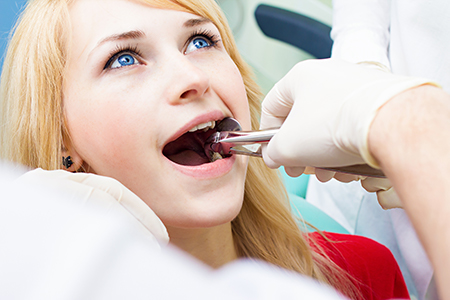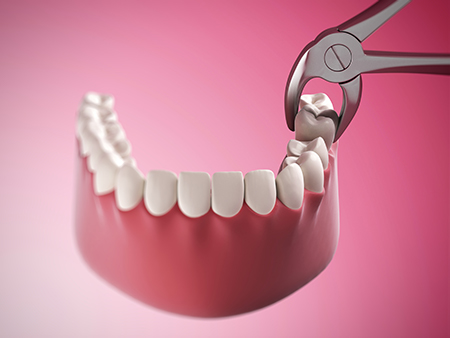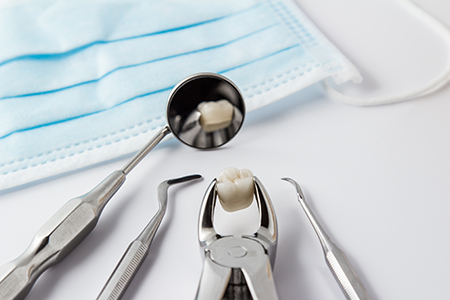
At the office of Newpoint Family Dental, our first goal is always to preserve natural teeth whenever possible. Modern restorative techniques allow us to save many teeth that once would have been removed. Even so, there are occasions when removing a tooth is the most responsible choice for long-term oral health, function, and comfort.
Deciding that a tooth should be extracted is a clinical judgment made after a careful exam and review of your medical history. Our team balances the desire to conserve tooth structure with the need to prevent ongoing pain, infection, or damage to neighboring teeth and supporting tissues. When extraction is recommended, it is because it supports a healthier, more stable outcome for your mouth.
We take time to explain why a removal is suggested and what the realistic alternatives are. You will receive clear pre-operative instructions, a discussion of sedation or anesthesia options when appropriate, and a plan for what comes next — whether that means short-term healing guidance or planning for a replacement tooth.
An over-retained baby tooth or one that is severely damaged
Baby (deciduous) teeth normally fall out as their permanent successors erupt. Occasionally a baby tooth remains firmly attached because its root did not resorb or because it has fused to the bone. When a retained baby tooth blocks proper development or alignment, careful extraction can make room for the permanent tooth and support healthier dental growth.
A permanent tooth that cannot be restored
Tooth decay begins on the outer enamel and can spread inward if untreated. When a tooth loses too much structure, or when infection has damaged the nerve and supporting tissues beyond repair, restoration may no longer be possible. In these cases, extraction removes the source of infection and prevents further oral health complications.
A tooth fractured beyond repair
Teeth can sustain cracks or breaks from injury, large fillings, or long-standing wear. Some fractures are minor and can be restored, but when a crack extends into the root or the remaining crown structure is insufficient, removal may be the safest course to avoid ongoing pain and infection.
Advanced periodontal disease weakening the tooth’s support
Gum disease is a leading cause of tooth loss in adults. When periodontal disease has significantly diminished the bone and soft tissues that hold a tooth in place, the tooth may become loose or painful. Extraction can be necessary to preserve overall oral health and to make future restorative options feasible.
Problematic wisdom teeth
Third molars often arrive late and sometimes without enough space, causing impaction, decay, or pressure on adjacent teeth. When wisdom teeth are poorly positioned, infected, or contributing to bite problems, timely removal helps prevent future complications and protects nearby teeth and gum tissues.
Extractions to facilitate orthodontic treatment
Crowding results when jaw size and tooth size are mismatched. As part of a comprehensive orthodontic plan, removing selected teeth can create the space needed to align the bite and achieve stable, long-term results. Any extraction done for orthodontics is coordinated closely with your orthodontic provider.

Before any extraction, we perform a focused exam and review your full health history to identify any factors that might affect treatment. This includes medications, recent illnesses, and systemic health conditions. If you are taking blood thinners, have cardiovascular concerns, or require special medical clearance, we coordinate care with your physician to reduce risks and ensure safe treatment.
Imaging plays an important role in planning. Digital radiographs allow us to evaluate root shape, proximity to nerves or sinuses, and the relationship of adjacent teeth. This information helps us decide whether a straightforward removal will do or if a surgical approach — sometimes with a specialist — is the better option.
Comfort is central to our approach. Local anesthesia reliably numbs the area for most procedures; for patients with anxiety or for more complex cases, we’ll discuss additional sedation options. We’ll also go over clear pre-operative instructions so you know what to expect on the day of the appointment and how to arrive comfortably prepared.
A simple extraction is used when the tooth is fully visible in the mouth and the roots are accessible. After the tissues are numbed with local anesthesia, the dentist gently loosens the tooth and removes it using dental instruments. The process is designed to be efficient and minimally traumatic, with attention to comfort and tissue preservation.
Most simple extractions are completed quickly, and post-operative discomfort is typically manageable with over-the-counter pain relievers or a short course of prescription medication if needed. We will provide clear instructions on how to care for the site and what signs to watch for during the first 24–72 hours.
Surgical extraction is performed when a tooth is broken at or below the gumline, impacted, or fused to the bone. The dentist may make a small incision in the gum and remove a bit of bone to access the roots, or a referral to an oral and maxillofacial surgeon may be advisable for complex cases. Local anesthesia is used, and sedation can be arranged if appropriate.
Because surgical extractions can involve more manipulation of bone and soft tissue, the recovery may be a bit longer than for a simple extraction. We discuss all surgical steps beforehand, including the rationale for any referral, so you understand the process and the expected timeline for healing.

Recovery varies by procedure and individual health, but certain practices consistently support a smooth healing process. After the extraction, a blood clot forms in the socket and acts as a natural bandage. Protecting that clot during the first days is essential to prevent complications. We will give you straightforward guidance tailored to your situation.
Expect some swelling and mild to moderate soreness; these symptoms are normal and peak in the first 48 hours. Keeping the head elevated, using cold packs intermittently, and following medication directions can reduce discomfort. Avoiding strenuous activity for a short period helps prevent increased bleeding and swelling.
If stitches are placed, we’ll tell you whether they are dissolvable or if a follow-up is needed to remove them. You should also know the signs of normal versus abnormal healing so you can contact the office if anything unexpected occurs.
Apply and maintain pressure
A gauze pad will be placed over the extraction site to control bleeding. Bite gently but firmly on the gauze for the time we recommend. If bleeding persists, replace the gauze with a fresh pad and continue gentle pressure. Some oozing for up to 24 hours can be normal; call our office if bleeding is heavy or prolonged.
Be cautious while numb
Until the local anesthetic wears off, avoid chewing, touching, or putting pressure on the treated area to prevent accidental bites to the lips, cheeks, or tongue.
Follow prescribed medication directions
Antibiotics:
If an antibiotic is prescribed, take the full course exactly as directed to help prevent or treat infection.
Pain control:
Taking a pain reliever before the local anesthesia fully dissipates can help maintain comfort. Over-the-counter analgesics are effective for many patients; if stronger medication is prescribed, follow dosing instructions carefully.
Protect the healing clot
Avoid rinsing vigorously, using a straw, spitting forcefully, or smoking for at least the first 48–72 hours. These actions can dislodge the clot and lead to a painful condition called dry socket.
Reduce swelling with ice
Apply an ice pack to the outside of the face for about 10 minutes on and 10 minutes off during the first day to help limit swelling.
Avoid tobacco
Smoking and other tobacco products interfere with healing and increase the chance of complications. Refrain from tobacco use for at least one week following the extraction.
Choose gentle foods and stay hydrated
Stick to soft, lukewarm foods during the first few days and avoid hot, spicy, or carbonated beverages. Drink plenty of fluids but do so without a straw.
Maintain oral hygiene carefully
Keep your mouth clean with gentle brushing away from the extraction site. After the first 24 hours, you may rinse gently with a warm saltwater solution to refresh the area, but avoid vigorous swishing.
Attend follow-up visits as recommended
If sutures were placed or if your case was more complex, we will schedule follow-up care to monitor healing. Keeping these appointments ensures the best outcome.
If you notice increasing pain, persistent bleeding, rising swelling, fever, or any other concerning symptom, contact our office right away so we can evaluate you and provide necessary care.

Our team focuses on delivering care that is precise, gentle, and centered on your comfort. Procedures are tailored to each patient so that surgical decisions are made only when clearly indicated. We combine clinical experience with modern diagnostics to reduce treatment time and support predictable healing.
When a tooth is removed, we also prioritize planning for the future. Whether you are a candidate for a removable denture, a fixed bridge, or dental implants, we discuss options that best restore function and appearance while protecting adjacent teeth and bone. Dental implants, when appropriate, provide a durable and natural-feeling replacement that helps preserve jaw structure.
Above all, our goal is to help you move from a painful or problematic tooth to a healthy, stable result with minimal disruption to your life. Clear communication, individualized care plans, and attentive follow-up are the hallmarks of how we approach extractions.
In summary, tooth extraction is sometimes the most appropriate step to protect your overall oral health. We aim to make the process understandable, comfortable, and safe, and to help you navigate the choices that follow. Contact us for more information or to discuss whether an extraction is the right option for you.
Preserving natural teeth is always the primary goal, but extraction becomes the best option when a tooth is extensively decayed, fractured beyond repair, or is the source of ongoing infection that threatens neighboring teeth and tissues. Extraction may also be recommended for severely mobile teeth caused by advanced periodontal disease, problematic wisdom teeth that are impacted or causing crowding, or when a retained baby tooth interferes with proper dental development. In orthodontic cases, removing specific teeth can create space needed to align the bite and achieve a stable result.
The decision to extract is made after a careful clinical exam and review of your medical history, with imaging to assess root shape and proximity to nerves or sinuses. Your dental team will explain realistic alternatives, outline the recommended approach, and discuss how extraction supports a healthier long-term outcome for your mouth.
A simple extraction is chosen when the tooth is fully visible in the mouth and the roots are accessible; the dentist numbs the area and removes the tooth using instruments that gently loosen and lift the tooth from its socket. These procedures are typically quick and focused on preserving surrounding tissue while controlling bleeding and discomfort. Most routine single-rooted teeth and some multi-rooted teeth can be removed this way.
Surgical extraction is used when a tooth is broken at or below the gumline, impacted, or fused to the bone, and it may involve making a small incision and removing bone to access the roots. Digital radiographs and other imaging inform this decision, and in complex cases a referral to an oral and maxillofacial surgeon may be recommended. Your clinician will discuss the rationale for any surgical approach and what to expect during recovery.
Before your appointment, provide a complete medical history including current medications, recent illnesses, and any systemic conditions, since these factors can affect treatment choices and healing. If you take blood thinners or have cardiovascular concerns, we coordinate with your physician to adjust care as needed for safety. For patients planning sedation, follow any fasting or medication instructions the team provides and arrange transportation home after the procedure.
Bring a list of questions and any imaging or records from other providers that may be relevant, and arrive well rested so you are comfortable during the visit. We will review pre-operative instructions with you, confirm anesthesia or sedation plans, and make sure you understand post-operative care before the extraction begins.
Local anesthesia is the standard method to numb the area around the tooth and typically provides reliable comfort for most extractions while you remain awake and responsive. For patients with dental anxiety or for more complex surgical procedures, additional sedation options such as nitrous oxide (laughing gas), oral sedation, or intravenous (IV) sedation can be discussed. The choice of sedation depends on your medical history, procedure complexity, and personal comfort preferences.
Your dental team will explain the benefits and limitations of each option and monitor you throughout the appointment to ensure safety. If deeper sedation or general anesthesia is recommended, the visit may take place with a specialist who is equipped to manage those anesthetic levels and post-operative recovery.
After numbing the area, the dentist will gently loosen the tooth and remove it using appropriate instruments; a simple extraction often takes only a short time while surgical extractions may require an incision or minor bone removal to access the roots. You may feel pressure during the procedure but not sharp pain once anesthesia has taken effect. If sutures are needed, they will be placed to support healing and protect the extraction site.
After the tooth is removed the team will place gauze to control bleeding and review post-operative instructions including how to manage discomfort and swelling. If sedation was used, recovery time in the office will vary and you should follow guidance about activity restrictions and transportation home. The clinician will also discuss a plan for follow-up care and any necessary referrals for complex cases.
Protecting the blood clot that forms in the socket is essential, so bite gently on gauze as instructed to control bleeding and avoid actions that could dislodge the clot, such as using a straw, vigorous rinsing, or smoking. Expect some swelling and discomfort that typically peaks in the first 48 hours; applying cold packs intermittently and keeping your head elevated helps reduce swelling. Take medications exactly as directed to manage pain and, if prescribed, complete the full course of any antibiotics.
Maintain gentle oral hygiene by brushing away from the surgical area and, after the first 24 hours, rinse gently with warm salt water to keep the site clean. Stick to soft, lukewarm foods for the first few days and gradually reintroduce firmer items as healing progresses. If stitches were placed, follow instructions regarding their care and attend any recommended follow-up appointments.
While most extractions heal without issue, you should contact the office if you experience increasing or severe pain after the first couple of days, heavy or prolonged bleeding, rising swelling, fever, or a foul taste or discharge from the socket. These symptoms can indicate infection, uncontrolled bleeding, or other complications that require prompt attention. Numbness that persists beyond expected anesthesia recovery may signal nerve involvement and should be evaluated.
A painful condition called dry socket can occur when the clot is dislodged, causing exposed bone and intense pain a few days after extraction; if you suspect dry socket or notice any concerning changes, reach out right away so the team can assess you and provide appropriate care. Early intervention helps prevent more serious problems and supports faster recovery.
Removing a tooth can lead to changes over time if the space is not managed, because adjacent teeth may shift toward the gap and opposing teeth can overerupt, which may alter your bite and function. Bone in the extraction site also remodels after a tooth is removed, potentially affecting the contours of the jaw in that area. The degree of change depends on the tooth removed, its location, and individual anatomical factors.
To limit long-term effects, your dentist will discuss replacement options and timing that help preserve jaw structure and maintain proper alignment. In orthodontic cases, extractions are planned as part of a broader strategy to achieve a stable bite, and when appropriate, bone-preserving techniques and restorative solutions like implants can be considered to support lasting function and appearance.
Common replacement options include removable partial dentures, fixed bridges that anchor to adjacent teeth, and dental implants that replace the tooth root and crown for a more permanent solution. Each option has specific clinical indications: implants are favored for long-term bone preservation and natural function when sufficient bone and healthy tissues are present, while bridges and dentures can be appropriate alternatives depending on adjacent tooth health and patient goals. Your clinician will review which choices best fit your oral health and long-term plan.
Timing for replacement varies—some patients may be candidates for immediate replacement, while others benefit from a period of healing or bone grafting before definitive restoration. The dental team will coordinate treatment sequencing, discuss any preparatory procedures needed to optimize outcomes, and help you understand the expected timeline for restoring function and appearance.
The team at the office of Newpoint Family Dental emphasizes careful evaluation, modern diagnostics, and treatments tailored to each patient so that extractions are recommended only when they clearly support long-term oral health. Our clinicians take time to explain options, discuss anesthesia and comfort measures, and coordinate with medical providers when necessary to reduce risk and promote safe care. Comfort-focused techniques and clear pre- and post-operative instructions help make the experience as predictable and manageable as possible.
We also prioritize planning for what comes next, whether that means monitoring healing, scheduling follow-up care, or discussing restorative solutions to replace the extracted tooth. Open communication, evidence-based decision making, and attentive follow-up are central to how we approach extractions and the ongoing health of your smile.
Our mission is to help every patient enjoy healthy teeth and a confident smile, providing care that meets your needs and exceeds expectations.
